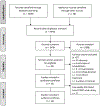Rehabilitation Interventions in Systemic Sclerosis: A Systematic Review and Future Directions
- PMID: 34165263
- PMCID: PMC8695630
- DOI: 10.1002/acr.24737
Rehabilitation Interventions in Systemic Sclerosis: A Systematic Review and Future Directions
Abstract
Objective: To systematically review evidence of rehabilitation interventions for improving outcomes in systemic sclerosis (SSc) and to evaluate evidence quality.
Methods: Several electronic databases were searched to identify studies in which rehabilitation professionals delivered, supervised, or participated in interventions for individuals with SSc. Randomized controlled trials (RCTs) or non-randomized trials, one-arm trials, and prospective quasi-experimental studies with interventions were included if they had ≥10 participants. Quality appraisal was conducted by 2 independent raters using the Physiotherapy Evidence Database (PEDro) Scale.
Results: A total of 16 good or excellent quality studies (15 RCTs, 1 prospective quasi-experimental study) were included. Most rehabilitation interventions focused on hands/upper extremities, followed by multicomponent, orofacial, and directed self-management. Sample sizes varied between 20-267 participants (median 38). In 50% of studies, participants in intervention groups significantly improved compared to controls. Most studies demonstrated within-group improvements in intervention groups. Interventions varied in content, delivery, length, and dose and outcome measures collected.
Conclusion: Existing evidence provides some support for rehabilitation in SSc, such as interventions that focus on hand and upper extremity outcomes or are multicomponent, although there is high study heterogeneity. The evidence base would benefit from interventions testing similar replicable components, use of common outcome measures, and incorporation of delivery modes that enable larger sample sizes. There are challenges in recruiting participants due to the rarity of SSc and high disease burden, as participants' involvement in rehabilitation studies requires active participation over time. Intervention studies designed to reduce participation barriers may facilitate translation of effective interventions into practice.
© 2021, American College of Rheumatology.
Conflict of interest statement
Conflict of Interest: authors have no conflict of interest to disclose.
Figures
References
-
- Bolster M, Silver R. Clinical features of systemic sclerosis. In: Hochberg MC, Smolen JS, Weinblatt ME, Weisman MH, editors. Rheumatology. 5th ed. Philadelphia: Mosby, Elsevier; 2011. 1373–86.
-
- Domsic RT, Medsger TA Jr. Disease subsets in clinical practice. In: Varga J, Denton C, Wigley FM, Allanore Y, Kuwana M, Eds. Scleroderma: From Pathogenesis to Comprehensive Management 2nd Ed; 2017. 39–48.
-
- Richards HL, Herrick AL, Griffin K, Gwilliam PDH, Loukes J, Fortune DG. Systemic sclerosis: patients’ perceptions of their condition. Arthritis Care Res. 2003;49(5):689–96. - PubMed
-
- van Lankveld WGJM, Vonk MC, Teunissen H, van den Hoogen FHJ. Appearance self-esteem in systemic sclerosis - Subjective experience of skin deformity and its relationship with physician-assessed skin involvement, disease status and psychological variables. Rheumatology. 2007;46(5):872–6. - PubMed



